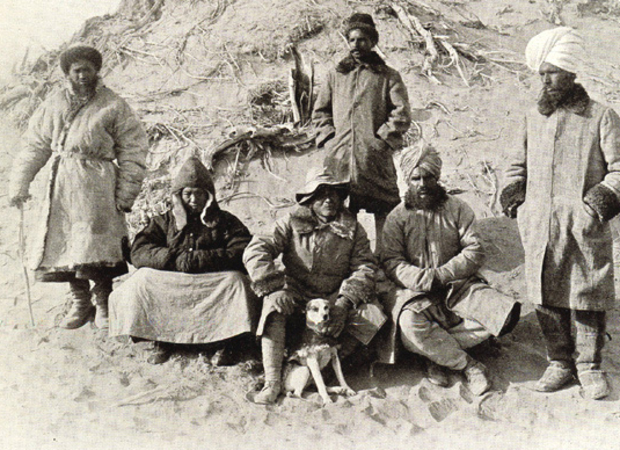Dispatches From Xinjiang: Cultural Appropriation And The Singer Luo Lin, a.k.a. “Dao Lang”
Luo Lin has in effect claimed ownership over a whole group of people, a sacred landscape and spiritual practice.
“We’re Uyghurs. We’re Not Terrorists.” A Plea From Xinjiang
A plea from a Xinjiang native stirred up discussions of how to make peace with people from different ethnic backgrounds on Weibo. “We’re from Xinjiang. We’re Uyghurs. We’re not terrorists. There are good people and bad...
Unrest In Xinjiang Incites Military Crackdown
State-run media reported that more than 100 people riding motorcycles, some wielding knives, attacked a police station in remote Hotan on Friday. It follows Wednesday’s clashes elsewhere in Xinjiang which killed 35. At a meeting chaired by...
Ministry of Truth: Xinjiang Violence
27 people are dead after crowds attacked a police station and other government offices yesterday. The police opened fire, killing at least 10. The motive for the riot is still unclear, but ethnic tension is high in the majority Uyghur region. ...
27 Die in Rioting in Ethnically Divided Western China
At least 27 people died in rioting in far western China on Wednesday, when protesters attacked a police station and government offices and the police fired on the crowd, state media said. It was the worst spasm of violence for years in...
Settlers in Xinjiang: Circling the Wagons
A network of immigrant settlements dominated by Han Chinese are adding to ethnic tensions by excluding ethnic Uighurs from commercial opportunities.
China Criticizes U.S. For Questioning Xinjiang Clash
In the wake of Tuesday’s violence, State Department spokesman Patrick Ventrell called for a thorough and transparent investigation and expressed concern over discrimination against Uighurs and the practice of Islam.
...
China’s Xinjiang Hit By Deadly Clashes
Clashes in China’s restive Xinjiang region have left 21 people dead, including 15 police officers and officials, authorities say. It is very difficult to verify reports from Xinjiang, reports the BBC’s Celia Hatton...
China’s Sufis: The Shrines Behind the Dunes
from New York Review of BooksLisa Ross’s luminous photographs are not our usual images of Xinjiang. One of China’s most turbulent areas, the huge autonomous region in the country’s northwest was brought under permanent Chinese control only in the mid-twentieth century....
China Convicts And Sentences 20 Accused Of Militant Separatism In Restive Region
“It’s not clear what is being alleged against these people beyond being members of a clandestine organization,” said Nicholas Bequelin, a researcher based in Hong Kong for Human Rights Watch.
The Hotan Project
Last May, Liu Xiaodong and a team of assistants traveled to Hotan, a town in the Xinjiang region of China, where he painted monumental portraits of local Uyghur jade miners while a documentarian filmed the entire process. The project is on view...

The Indiana Jones of China
from Sinica PodcastAfter his controversial involvement with the Tarim mummy excavations in Western Xinjiang, Victor Mair might just be the closest thing Sinology has to Indiana Jones, assuming the...

The Tree That Bleeds
In 1997 a small town in a remote part of China was shaken by violent protests that led to the imposition of martial law. Some said it was a peaceful demonstration that was brutally suppressed by the government; others that it was an act of terrorism. When Nick Holdstock arrived in 2001, the town was still bitterly divided. The main resentment was between the Uighurs (an ethnic minority in the region) and the Han (the ethnic majority in China).
Environmental and Social Impact Assessment: Urumqi District Heating Project
The city of Urumqi, the capital of Xinjiang Uygur Autonomous Region in westernmost China, is experiencing rapid urbanization and economic growth, which poses challenges to Urumqi Municipal Government in providing adequate and efficient public...
“Justice, Justice”: The July 2009 Protests in Xinjiang, China
On July 5, 2009, thousands of Chinese of Uighur ethnicity demonstrated in Urumqi, the regional capital of the Xinjiang Uighur Autonomous Region (XUAR). In the aftermath of the Urumqi protests, the authorities detained more than 1,400 people. In...
U.S.-China Counterterrorism Cooperation: Issues for U.S. Policy
After the terrorist attacks on September 11, 2001, the United States faced a challenge in enlisting the full support of the People’s Republic of China (PRC) in the counterterrorism fight against Al Qaeda. This effort raised short-term policy...
“We Are Afraid to Even Look for Them”: Enforced Disappearances in the Wake of Xinjiang’s Protests
In the aftermath of the July 2009 protests in Xinjiang province, which according to the Chinese government killed at least 197 people, Chinese security forces detained hundreds of people on suspicion of participating in the unrest. Dozens of...
China’s Area of Darkness
from New York Review of BooksThe very first anonymous star on the CIA’s wall of honor at Langley, Virginia (the agency rarely identifies its dead heroes), refers to Douglas MacKiernan, the agency’s man in Urumqi, the capital of what is now called the Xinjiang Uyghur...
China: Minority Exclusion, Marginalization and Rising Tensions
This report documents the serious impediments to the fulfillment of China's human rights obligations, in the areas of ethnic minority political participation, development, and preservation of cultural identity. Given the destabilizing levels of...
China’s Relations with Central Asian States and Problems with Terrorism
Over a number of years, the United States has been actively engaged in efforts to improve human rights conditions in the People’s Republic of China (PRC). However, some analysts suggest that the events of September 11, 2001, may make it more...




